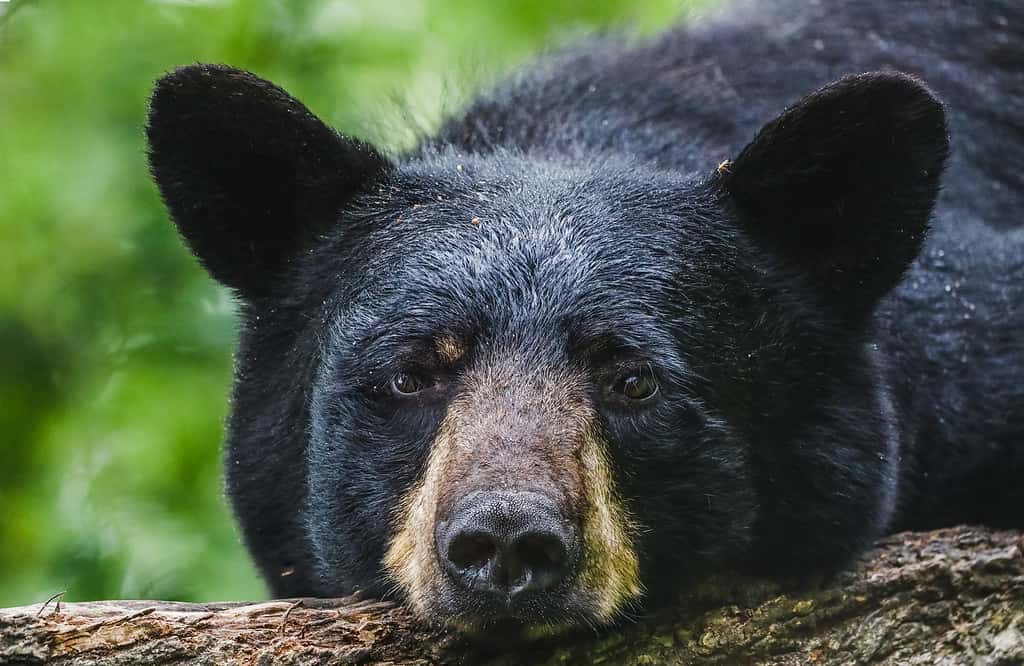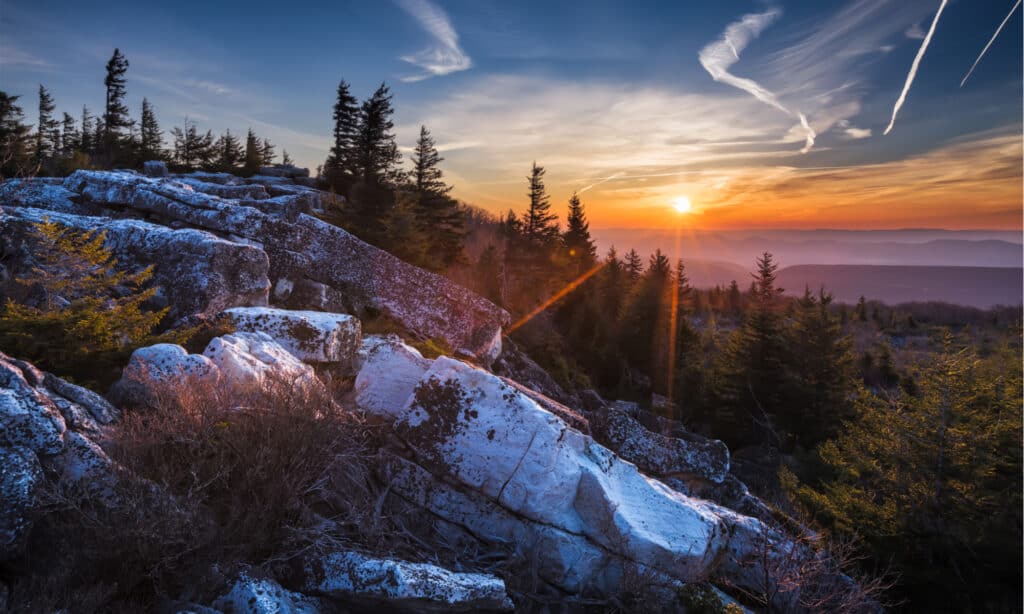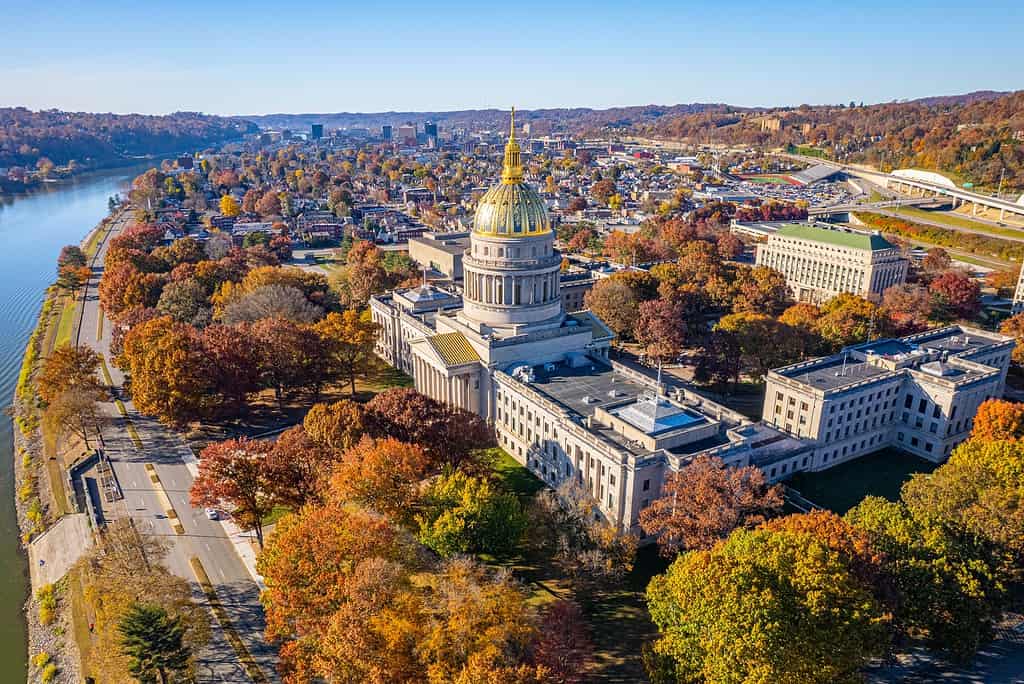American black bears (Ursus americanus) are the only type of bears living in West Virginia. About 12,000 to 14,000 of them live in the state. In fact, black bears are present in all 55 counties. With that said, the highest concentrations are in the rugged mountains and dense forests. If you’re new to West Virginia or just visiting, you’re most likely unfamiliar with the geography. No worries. Keep reading to find out which places you’re most likely to encounter a bear in West Virginia this winter before heading out into the wilderness.
Places You’re Most Likely to Encounter a Bear in West Virginia This Winter

Black bears start denning in late October to prepare for their winter-long nap.
©Mandy Fuller Photography/iStock / Getty Images Plus via Getty Images
You’re in luck if you’re afraid of a black bear encounter while enjoying outdoor winter activities. Despite their presence all over West Virginia, black bears enter torpor in winter. It’s a sleep state comparable to hibernation that keeps them in their dens starting in late October, remerging once temperatures warm up in March. However, they periodically leave their den or may not den at all in some cases due to unseasonably warm winter temperatures.
Most black bears will be asleep, but if you want to err on the side of caution, these are the places you’re most likely to encounter a bear in West Virginia this winter.
1. Monongahela National Forest

The Monongahela National Forest is the largest forest in West Virginia.
©Malachi Jacobs/Shutterstock.com
The Monongahela National Forest is located in the Allegheny Mountains and is the largest forest in West Virginia. The sprawling forest covers over 919,000 acres and includes Spruce Knob – the state’s highest point at 4,863 feet above sea level. It’s considered a “working forest” and is a popular tourist attraction for nature enthusiasts.
Most people exploring the Monongahela National Forest never encounter a bear. However, the land is home to various animal species, including migratory songbirds, whitetail deer, and black bears. The many rivers and streams throughout the forest provide a home for freshwater fish, such as the native brook trout, and food for the black bears.
There is a higher concentration of black bears in the remote and rugged Smoke Hole Canyon. Crevices along the 20-mile-long gorge are used for denning bears during winter. This hidden gem is one of the places you’re most likely to encounter a bear in West Virginia this winter if any of them stir from their winter nap.
2. Cranberry Wilderness

The Cranberry Wilderness was originally a black bear sanctuary.
©Andriy Blokhin/Shutterstock.com
The Cranberry Wilderness is in the Monongahela National Forest, but it gets its own spot on the list because of its history. The area is 47,815 acres with 14,000 acres of Cranberry Backcountry, featuring rugged mountains, streams, waterfalls, and swimming holes backpackers enjoy.
The area, bordered by the Williams River and the South Fork of the Cranberry River, was established in 1983 as a state black bear sanctuary. Black bears still roam the untamed wilderness alongside bobcats, foxes, and wild turkeys. The Cranberry Wilderness was selected to help rebuild the state’s black bear population in the 1970s because it was relatively isolated, and its location would allow the bears to spread out from the center of the state.
3. Canaan Valley

The Canaan Valley is home to high-altitude plants and animals.
©Eduard Moldoveanu/Shutterstock.com
The Black Bear Resort in the Canaan Valley has its name for a reason. The upland valley is located in Tucker County, 3,200 feet above sea level. Within the area, the Canaan Valley National Refuge protects 15,000 acres of land and the precious ecosystem that lives in it. Here, plants and animals typically living in northern altitudes find shelter in the undeveloped landscape and extensive wetlands.
Tucker County is a hot spot for West Virginia black bears. Over the years, the state’s black bear population has spread out from the central Cranberry Wilderness. As a result, black bears are frequently seen and photographed in the Canaan Valley National Wildlife Refuge, with large concentrations within the area’s eastern mountains and forests. However, they frequently make appearances in the nearby cities.
4. Kanawha State Forest

Charleston, the West Virginia capitol, is outside the Kanawha State Forest.
©Wirestock/iStock via Getty Images
The Kanawha State Forest is a 9,300-acre recreation area only a few miles outside of Charleston, the state’s capital. It’s also a nesting habitat for over a dozen species of wood warblers, attracting birders from as far as Canada to the beautiful forest. Black bears and bobcats frequent the Eastern Watershed Tracts of the Kanawha State Forest. Depending on the time of year, the tracts are also home to the threatened northern long-eared bat and the endangered Indiana bat.
Kanawha County is a black bear hub overall because of its proximity to the forest. Residents of Kanawha City and Charleston, especially, are seeing black bears more often. No injuries have occurred as a result of the encounters, but residents are fearful the bears will become increasingly more comfortable wandering the residential areas.
Charleston is one of the places you’re most likely to encounter a bear in West Virginia, although chances are lower in winter. Several black bears wearing tracking collars live only a few miles outside the city limits. The neighboring Boone County also sees bears who most likely wander over from the Kanawha State Forest.
5. Coopers Rock State Forest

A fugitive cooper is responsible for the Coopers Rock State Forest’s name.
©Mahmoud Younes/iStock via Getty Images
Coopers Rock State Forest is 12,747 acres of land named after the fugitive Cooper who worked and hid in the mountains. The scenic canyon overlooks and historical sites attract over 180,000 visitors to the forest every year. Plenty of wildlife finds refuge in the forest, including deer, black bears, bobcats, turkeys, and rattlesnakes.
Morgantown is only 13 miles away from Coopers Rock State Forest. Black bears live on the perimeter since the city is nestled in the rolling hills, so close to the forest. Just like in Charleston, monitored bears frequently venture close to the city’s urban and residential parts.
6. New River Gorge National Park & Preserve

©Sean Pavone/Shutterstock.com
Last but surely not least, the New River Gorge National Park & Preserve is one of the places you’re most likely to encounter a bear in West Virginia this winter. The 70,000-acre park offers unforgettable views and a variety of recreational activities. Most notably, the park is home to the famous whitewater river flowing through the gorge – the New River. Ironically, the New River is the oldest river in the United States.
You’re more likely to encounter raccoons and skunks while exploring the park, but black bears like to make an appearance. The nearby Raleigh, Greenbrier, and Monroe Counties see the most black bears. The city of Beckley in Raleigh County is cited alongside Charleston and Morgantown as seeing more bears getting comfortable near the city limits.
What to Do If You Encounter a Bear in West Virginia This Winter

Black bears rummage through household garbage cans and campsites for food.
©Tom Middleton/Shutterstock.com
Encountering a bear is rare. Black bears, in particular, are shy and reclusive. More often than not, they will run away before you can spot them. However, taking precautions is essential to avoid attracting bears to your home or campsite.
In winter, your chances of an encounter are low but not impossible. Bears leaving their dens during torpor should only be temporarily visible. They want to be left alone, but running into an aggressive bear is possible. Following the BearWise Basics can keep you and the bears safe if you encounter a bear in West Virginia this winter.
The photo featured at the top of this post is © mountinez/iStock / Getty Images Plus via Getty Images
Thank you for reading! Have some feedback for us? Contact the AZ Animals editorial team.






